Abstract
The morphostructure of inflorescences in the genus Coelogyne Lindl. was studied for the first time using a structural–rhythmological approach. Three species of Coelogyne were used to describe one-season, intercalary, and all-season inflorescences. In C. monilirachis, a new type of all-season inflorescence was identified, characterized by a prolonged sympodial growth of the rachis, lack of a pronounced dormant period, and thickening of all rachis internodes except the first. This inflorescence has been determined to be a compound monochasial cyme, with each floral unit represented by a separate flower. C. ovalis has a one-season inflorescence, with the floral unit being a determinate bracteous spike (stachyoid), and C. prolifera developed intercalary inflorescences united in an indeterminate bracteous spike.
1. Introduction
The distinction between inflorescences and the arrangement of flowers remains a subject of debate in the scientific community. Previously, the definition of “inflorescence” in classical morphology included its single-season continuous growth and dying off after flowering and fruiting [1,2]. This definition was suitable for flowering plants in seasonal climates but did not encompass the full range of inflorescences found in tropical and subtropical plants, including orchids with both single-season and perennial (intercalary) inflorescences [3,4].
Today, two methods of classifying inflorescences exist: morphological and structural. The morphological method is widely used, as it takes into account specific features of fully developed inflorescences [5]; however, it may be based on outdated definitions. The structural classification of inflorescences [6,7] forms the basis of modern comparative morphological classification, which is based on the study of patterns of mutual arrangement and development of vegetative and generative shoots in a complex [8,9]. The structural and rhythmological characteristics of generative shoots allow for the description of not only single-season, but also multi-season inflorescences. The rhythmological approach is a part of the structural approach [2].
The genus Coelogyne Lindl. (tribe Arethuseae, subtribe Coelogyninae) includes 182 to 200 species [10], found in India, Nepal, the Indochina peninsula (from Myanmar to Vietnam), China, Indonesia, the Philippine Islands, the Pacific Islands, and Sri Lanka. These epiphytes or lithophytes grow in moist habitats, from coastal lowland forests to high-altitude misty forests. Their flowers are adapted to pollination by bees and wasps [11]. Coelogyne have ornamental and medicinal importance [12,13,14]. Unlike other orchids, the genus Coelogyne is characterized by the diverse development of vegetative and generative shoots relative to each other, with proteranthous, hysteranthous, synanthous, and colovanthous inflorescences, as well as lateral (heteranthous) inflorescences [15,16,17]. Along with vertically directed inflorescences, some Coelogyne species also have drooping inflorescences, which are well-adapted to epiphytism in the crown of trees. As the genus features not only one-season but also perennial intercalary inflorescences, it makes an excellent model for studying the structure of inflorescences. The objective of this study was to identify the structural organization and rhythmological diversity features of inflorescences of C. monilirachis, C. ovalis, and C. prolifera.
2. Materials and Methods
We conducted a study on the inflorescences of orchids belonging to the genus Coelogyne, which showed variation in structure and duration of development. Three species from different sections were chosen as model subjects: C. ovalis from the section Fuliginosae Lindl., which has a single-season inflorescence (Figure 1A); C. prolifera from the section Proliferae Lindl., which has intercalary inflorescences (Figure 1B); and C. monilirachis from the section Moniliformes Carr., which has indeterminate inflorescence (Figure 1C). The experimental plants were grown in a warm (winter night temperature of 16–18 °C) and moderate temperature (winter night temperature of 12–16 °C) greenhouse with natural light and increased humidity of 60–75%. Epiphytic Coelogyne species were grown in plastic baskets (25 × 25 cm); the substrate was a mixture of chopped pine cortex, fern roots, and sphagnum moss (1:1:1). Fertilization was performed using liquid mineral fertilizer from Bona Forte (Russia), concentration 0.01%, once a week. Disease management was monitored every week. Seven developed generative shoots were selected from each sample, and their morphological structure, rhythmological development, and formation of the apical bud were studied. The distribution of vascular bundles in the peduncle and rachis was also analyzed through transverse and longitudinal sections.
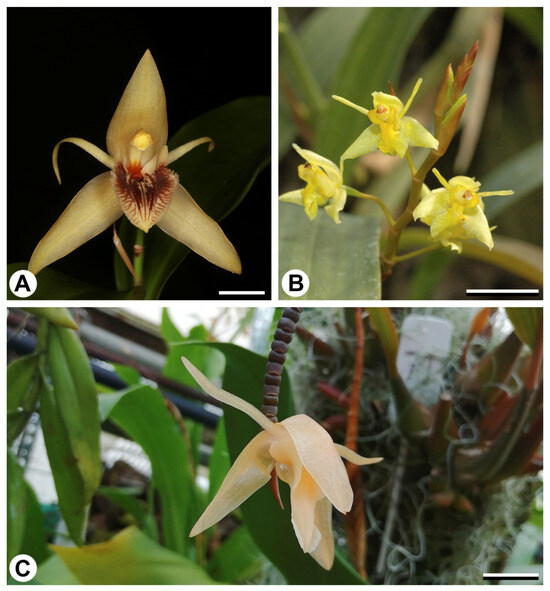
Figure 1.
Flowers of Coelogyne species: (A) C. ovalis; (B) C. prolifera; (C) C. monilirachis. Scale bars: (A,C) = 1.5 cm; (B) = 1 cm.
The plant material was fixed in a 70% ethanol solution. The production of permanent preparations of transverse and longitudinal sections was carried out using an MS-2 slide microtome (Yekaterinburg, Russia) with a connected OMT-2802E freezing table (Yekaterinburg, Russia). The thickness of the obtained sections was 30–50 µm. Preparations for revealing lignification zones were stained with safranin and alcyan blue [18]. A light microscope (Olympus CX4, Shinjuku, Tokyo, Japan) was used for obtaining images and subsequent analysis.
The morphological and structural–rhythmological characteristics of the inflorescence were analyzed, including the following terms and concepts: The floral unit (synflorescence) is defined as a set of flowers on the main axis of the inflorescence and is considered as an elementary block in the structure of the flowering shoot. The floral zone is a segment of the main axis of the annual growth (season) where the flowers are located. An intercalary inflorescence is a perennial generative shoot with a periodic monopodial growth and sequential arrangement of several floral zones. The main axis of the inflorescence is divided into the stem part of the axis (peduncle) and the flower-bearing part of the axis (rachis). The leaf row of the inflorescence has (1) basal bracts located at the base of the main axis, (2) median bracts located on the peduncle but without flower buds, and (3) floral bracts (pherophylls) located on the rachis that hold a flower in the axil. The resupination of the flower is where the twisting of the ovary rotates the flower 180° and brings the labellum into an abaxial position.
3. Results
3.1. Structural Organization and Rhythmological Features of Coelogyne ovalis Inflorescence
Under greenhouse conditions, C. ovalis experiences the following developmental rhythms: the vegetative shoot develops from October to August of the next year, while the inflorescence develops from April to September–October. The inflorescence is 5–9 cm long and is either erect or arched, emerging from the top of a mature, thickened pseudobulb. The type of inflorescence formation is hysteranthous, and the pseudobulb thickening occurs simultaneously with the beginning of the generative zone’s growth at its top. The inflorescence develops continuously (silleptically) and bears 1–4 flowers. The flowers are resupinate (as depicted in Figure 2A) and sessile, arranged in an alternate, slightly zigzag formation on the inflorescence’s two-row short rachis. The peduncle bears three median bracts. The rachis develops 2–5 bracts (pherophylls), in the axils of which 2–5 flowers develop. The last bract surrounds the rudimentary apical flower, which does not develop further. Figure 2B shows a longitudinal section of the rudimentary apical flower inside the last bract.
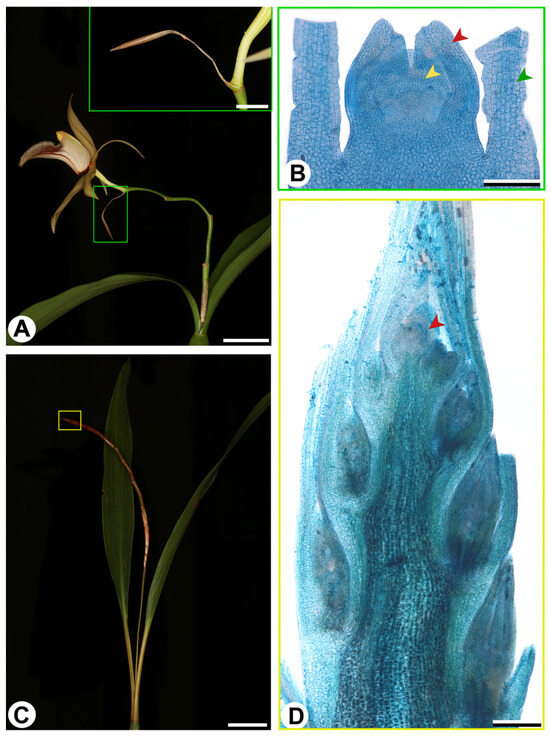
Figure 2.
Inflorescences of C. ovalis and C. prolifera. (A) One-season inflorescence and flower of C. ovalis, green inset—last undeveloped bud with rudiment of apical flower; (B) rudimentary apical flower of C. ovalis, red arrow—rudiments of sepals, yellow arrow—rudiment of gynostemium, green arrow—bract; (C) inflorescence of C. prolifera with two intercalary clusters; (D) structure of the apical floral zone of C. prolifera with flower primordia in the axils of bracts; red arrow, apical meristem. Scale bars: (A) = 2 cm (green inset = 0.5 cm); (C) = 1.5 cm; (B,D) = 0.6 mm.
Therefore, the inflorescence of C. ovalis develops over one season and is composed of two morphologically distinct sections: a short peduncle (2–5 mm) with closely spaced internodes, and a rachis with longer internodes, bearing sessile flowers and ending with a rudimentary apical flower. The floral unit is a bracteous spike. In terms of structural–rhythmological morphology, this inflorescence with an elongated first-order axis, short second-order axes, and a terminal flower at the top is called a stachyoid.
3.2. Structural Organization and Rhythmological Features of Coelogyne prolifera Inflorescence
The rhythmological type of mutual development of the vegetative and generative spheres in C. prolifera is defined as vegetative-leading (hysteranthous). The inflorescence is erect, measuring 15–30 cm in length, and is characterized by an intercalary flowering sequence and periodic growth for 2–4 seasons. In greenhouse conditions, the plant blooms from late spring to early summer, with an adult plant often having multiple, simultaneously flowering intercalary inflorescences of varying ages.
The single axis of the inflorescence develops seasonal floral zones, which consist of two types of bracts: sterile and true (Figure 2C). These clusters, referred to as the floral zones of the intercalary inflorescence, are morphologically well isolated along the main axis. The peduncle, the section from the base to the first shortened internode of the first floral zone, is completely smooth and lacks any buds or true bracts. The transverse section of the peduncle axis exhibits an atactostele (a variation of the eustele). The distal part of the peduncle slightly thickens before the first floral zone.
Each floral zone is divided into two sections: the lower section comprises short internodes and sterile bracts without axillary flower buds, while the upper section comprises longer internodes and bracts with immature axillary flowers. The floral bracts (pherophylls) of the floral zone are larger in comparison to the sterile bracts. Each floral zone can produce 3 to 10 resupinate flowers that open acropetally. The floral zone has the structure of a simple spike, with axillary sessile flowers and all bracts arranged in two rows, overlapping one another. During blooming, the flower-bearing bracts typically fall off, while the sterile bracts remain on the axis until the death of the entire inflorescence. Each subsequent floral zone of intercalary inflorescence begins to develop a year prior to the flowering of the previous floral zone. After the first flowering has ended, the generative shoot continues to grow slowly, forming short internodes with sterile bracts without flower buds. The blooming of the second floral zone is accompanied by elongation of the internodes with floral bracts and axillary flowers, and the process repeats.
The terminal floral zone of the intercalary inflorescence resembles the one-season inflorescence morphologically. The unrealized floral zones at the end of the main axis of C. prolifera can be seen as apical dormant flower buds protected by bracts from unfavorable conditions (Figure 2D). These zones develop with a rest period (proleptically) that is implicitly expressed. Each floral zone on the main axis of the intercalary inflorescence consists of two sections: a fertile section with flower primordia, long internodes (auxiblasts) and floral bracts that fall off during flowering, and a sterile section without flower buds, with short internodes (brachyblasts) and sterile bracts that do not fall off. Sterile bracts remain on the inflorescence until it dies. Floral bracts fall off during flowering as a result of the increasing size of the flowers and their resupination.
The zigzag structure of the flower-bearing section of the floral zone is likely the result of the alternating arrangement of developed flower buds. Thus, the inflorescence of C. prolifera is intercalary, each floral zone is an open bracteous spike, and there are no paracladia.
3.3. Structural Organization and Rhythmological Features of Coelogyne monilirachis Inflorescence
The type of inflorescence development of C. monilirachis is hysteranthous. The pseudobulb and a single apical leaf mature fully prior to flowering. The inflorescences are distinguishable by their purple color and indefinite growth in length, with a thickening of the internodes of the rachis. Our studies demonstrate that the inflorescences of C. monilirachis can continue growing for at least five years, producing over 40 flowers in total. Initially, the inflorescence grows in an arc or horizontally parallel to the leaf blade (Figure 3A), but as the distal part becomes heavier, the inflorescence droops and its apex points vertically downwards (Figure 3B). The flowers are resupinate and the bracts are short-lived, falling off before the flowers fully form and open.
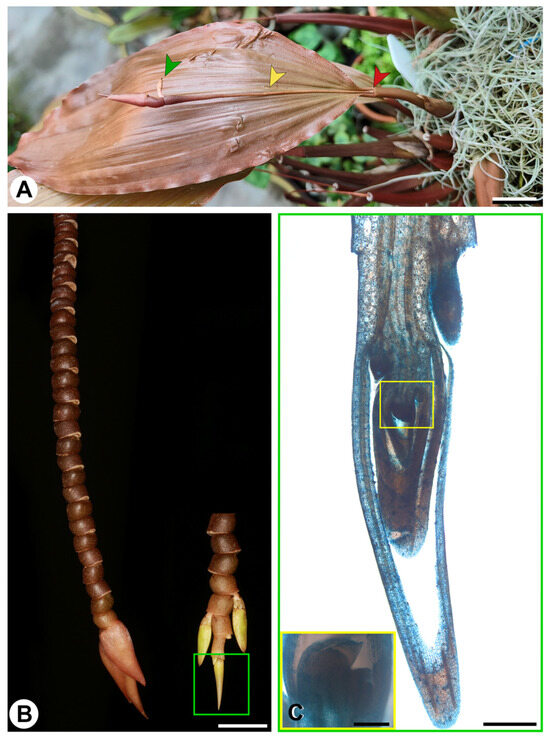
Figure 3.
Inflorescence of C. monilirachis. (A) Stage of formation of the first floral unit, red arrow—stem section of the inflorescence (peduncle), yellow arrow—elongated first floral unit of the rachis, green arrow—resupinate apical flower of the first floral unit; (B) distal part of the rachis of a 5-year-old generative shoot; inset: morphological structure of the inflorescence tip without bracts and with non-resupinated flower buds; (C) longitudinal section of the inflorescence apex; inset—spherical meristem of apical flowers of two successive axes. Scale bars: (A) = 1 cm; (B) = 1 cm; (C) = 1 mm (inset = 0.2 mm).
We have identified a unique form of development in the perennial inflorescence of C. monilirachis that lacks intercalary flower arrangement and floral zone segregation. Each internode of the inflorescence can be considered as a module, comprising an apical flower and an axillary rudiment of the next higher-order module (Figure 3C). This continuously reproducing modular system does not possess a constantly growing apical meristem. Instead, its growth is driven by the sympodial development of modules with a single terminal flower.
The inflorescence of C. monilirachis is divided into two parts: a very small peduncle, consisting of one internode measuring 1 to 3 mm in length, and a rachis, which comprises a very long internode of the first floral unit and short, expanded internodes of subsequent branching orders. The first internode of the rachis is a long axis slightly widened at the top of the apex, which ends in a bract with an axillary apical flower. In the axil of this bract, located next to the flower, a second-order axis develops with an apical flower and a third-order axis, and so on. The morphostructure of the rachis with this type of growth pattern and continuous duration has not yet been thoroughly studied. It has only been identified in the Moniliformes section.
A comparative analysis of the anatomical sections of the peduncle and rachis internodes showed that the vascular bundles of the peduncle correspond to the structure of the monocotyledon stem (atactostele), while the vascular bundles of the first rachis internode and all its subsequent thickened internodes are located in a circle in the central zone (Figure 4A,B). On the transverse section of the first elongated internode of the rachis, it can be seen that the collateral vascular bundles are closed and arranged in a ring circle. This pattern is characterized by a well-defined boundary with mechanical properties as shown in Figure 4C. In transverse sections, the epidermis consists of a single row of sclerified cells (Figure 4D). In transverse sections, parenchyma is 7–10-layered with hypertrophied cells in the third–seventh layers. Thickening of the internodes of the rachis occurs due to an increase in the number of cell layers of the parenchyma (up to 10–15 layers) and a denser arrangement of hypertrophied cells. The location of the vascular bundles in the zone of thickened internodes of the rachis is closer to the center (Figure 5A). In longitudinal sections, the median vascular bundles are short and branch near the flowers (Figure 5B). The thickened rachis internodes have collateral vascular bundles that are typical of monocots and lack a cambium (Figure 5C). The thickened internodes of the rachis have a thin, lignified epidermis (Figure 5D).
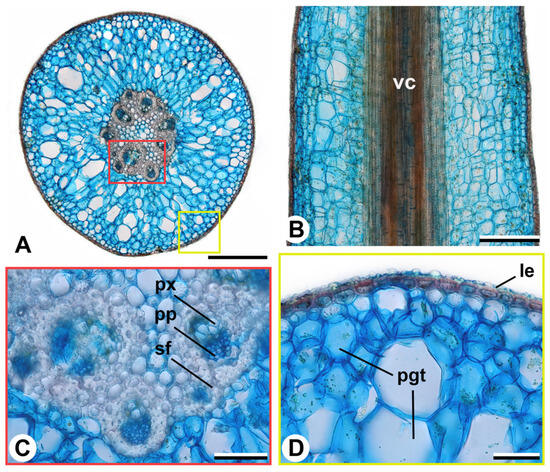
Figure 4.
Anatomical structure of the first floral unit of the rachis of C. monilirachis. (A) Cross section; (B) longitudinal section; (C) closed collateral vascular bundles; (D) cross section of the peripheral zone with hypertrophied parenchyma cells. Abbreviations: px, primary xylem; pp, primary phloem; sf, sclerenchyma fiber; pgt, parenchymatous ground tissue; le, lignified epidermis; vc, vascular cylinder. Scale bars: (A,B) = 0.25 cm; (C) = 0.05 mm; (D) = 0.04 mm.
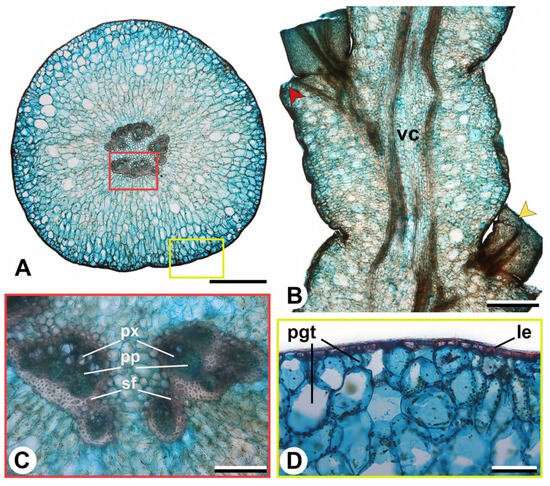
Figure 5.
Anatomical structure of the thickened internode of the rachis of C. monilirachis. (A) Cross section; (B) longitudinal section with removed bracts and rudimentary flowers, red arrow—place of attachment of the removed bract, yellow arrow—base of the ovary of the removed flower; (C) closed collateral vascular bundles; (D) cross section of the peripheral zone with hypertrophied parenchyma cells. Abbreviations: px, primary xylem; pp, primary phloem; sf, sclerenchyma fiber; pgt, parenchymatous ground tissue; le, lignified epidermis; vc, vascular cylinder. Scale bars: (A,B) = 1 cm; (C) = 0.2 mm; (D) = 0.1 mm.
The anatomical structure of the inflorescences of C. monilirachis supports the conclusion that the elongated first flower internode is not a peduncle, but rather a part of the rachis. The reason for the continuous development of the inflorescences over multiple years is due to the sympodial growth of individual floral units, rather than the monopodial growth of the main axis.
Based solely on morphological features, the inflorescence of C. monilirachis could be mistaken for a simple spike with sessile flowers and an unusually thickened rachis internode, and an open top. However, the positioning of the axes and their continuous sympodial growth suggest that the generative shoot of this orchid is actually an indeterminate compound monochasium, in which each floral unit is represented by a separate flower. In accordance with the idea of a single-season inflorescence, it is suggested to characterize the inflorescence of C. monilirachis as an all-season inflorescence, due to its continuous perennial growth and consistent flowering.
4. Discussion
4.1. Structural–Rhythmological Patterns for Coelogyne Inflorescences
The diversity of flowers and inflorescences within the Orchidaceae family demonstrates the extreme evolutionary variability of its reproductive structures [19,20]. The impressive morphological diversity of tropical orchid flowers has been well known since the time of the great geographical discoveries, and their pollination mechanisms were even studied by Charles Darwin [21]. Despite this, the morphology of orchid inflorescences has received less attention compared to flowers, despite their crucial role in pollinator attraction and increasing seed propagation [21]. The architecture, orientation, and lifespan of orchid inflorescences are determined not only by environmental and genetic factors, but also by selective pressure from pollinators [22]. The findings of classical works on the morphology and structure of inflorescences [1,6,23] underwent significant revision at the beginning of the 21st century [24,25].
The term “inflorescence” was first introduced into botany by Carl Linnaeus in his work Philosophia Botanica. He also introduced terms related to the structure of inflorescences, such as stem (scapus), peduncle (pedunculus), and pedicel (pedicellus) [26]. Linnaeus and his followers established the foundation for the morphological method of classifying inflorescences and introduced inflorescence types such as raceme, spike, capitulum, spadix, and umbel (simple or complex). The concept of cymose and racemose inflorescences was introduced by Parkin [27]. During the 20th century, ideas regarding the structural approach to classifying inflorescences [7] and their phylogeny [28,29] were developed. Additionally, terms such as “florescence”, “synflorescence”, and “polytelic synflorescence” were introduced [1,6,30]. Efforts to standardize approaches to describing inflorescences and unifying terminology have not yet produced a complete and exhaustive definition of the inflorescence due to the lack of consensus [31].
The interpretation of the term “inflorescence” from a rhythmological perspective encompasses only one stage of visible inflorescence growth formed through syllepsis (simultaneous growth of maternal and lateral shoots without a dormant period) [32]. As such, inflorescences that persist for just one season correspond to a single structural unit (or module, or floral unit). According to the structural approach, an inflorescence is always an annual shoot [23]. The introduction of terminology for a generative shoot that persists over multiple seasons into the Troll system resulted in the use of terms such as “successive flowering” [33], “perennial inflorescence” [34], “inflorescence with prolepsis” (i.e., the development of second-order axes following a dormant period) [33], and “intercalary flowering” [9]. Conflicts in conceptual and terminological aspects of inflorescence morphology have led to the development of a new understanding of inflorescences that considers ontogeny and various types of meristems and developmental features [35].
The modification of the leaves is a key characteristic of inflorescences in flowering plants [36,37]. Inflorescences are classified based on the presence and size of foliage leaves or bracts as frondose (leafy), bracteate (with bracts), or ebracteate (without bracts). Additionally, based on location, there are pherophylls (covering leaves on the inflorescence axis, with flowers formed in their axils), bracts (developing on the flower peduncle), and bracteoles (secondary bracts subtending a flower within inflorescence) [38]. The same leaf series structure of an inflorescence can be referred to with different terms, depending on the morphological approach and the goals of the study.
Inflorescences of Coelogyne do not exhibit branching or form paracladia. The flowers are sessile, lacking prominent pedicels. The series of bracts in the inflorescence includes basal, median (with inhibited axillary buds), and floral bracts [15]. Our studies have revealed the elimination of some elements of the leaf series in the Coelogyne inflorescence, which is determined by the rhythms of the inflorescence development (proteranthous, synanthous), as well as the duration of flowering (single-season, intercalary, all-season).
4.2. One-Season Inflorescences of C. ovalis
C. ovalis, with one-season inflorescences, is a cold-loving, epiphytic or lithophytic orchid found in the mountainous regions of Indochina, where it grows at altitudes of 1200–3200 m. The stem has a single swollen internode and a thin rhizome that is 4–6 cm in length. The pseudobulbs of this species are used as a raw material in Chinese medicine [12,13,14,39]. In natural habitats in India, the species blooms from June to January [31]; in our greenhouse, it blooms from September to January [15]. The type of inflorescence formation is hysteranthous [16]. Previous literature reports that the main axis of the inflorescence in C. ovalis carries three median bracts and one bract [15,40]. However, our observations show that the flowering period can last longer, with the potential for up to five bracts and four mature flowers to develop on a single inflorescence. In morphological and taxonomic studies, the inflorescence of Coelogyne is considered an open raceme [16]. However, the presence of an apical flower without signs of an abortive apex or an unrealized apical meristem indicates the closed nature of the inflorescence. We consider such an inflorescence a closed spike or stachyoid (Figure 6A).
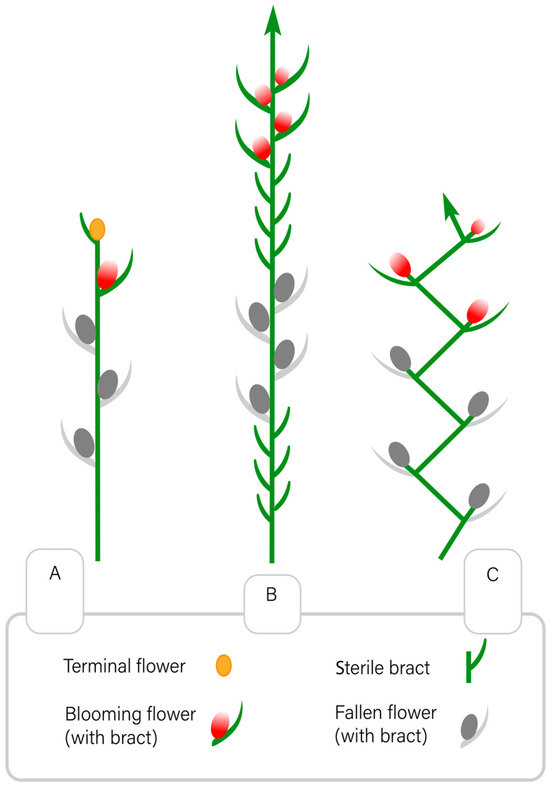
Figure 6.
Schematic views of inflorescences: (A) C. ovalis: determinate bracteous spike (stachyoid); (B) C. prolifera: indeterminate bracteous spike (intercalary inflorescence); (C) C. monilirachis: compound monochasial cyme.
4.3. Intercalary Inflorescences of C. prolifera
In C. prolifera, we have described a type of intercalary inflorescence (Figure 6B) which is rare in Coelogyne. The main axis of the inflorescence forms several floral zones and grows monopodially for an extended period. Two elements of the leaf series of intercalary inflorescences were identified: sterile bracts (without flower buds) and bracts. One of the reasons for the development of large floral bracts is to protect flowers from changes in temperature and humidity during unfavorable seasons. This adaptation allows some species of the subtribe Coelogyninae to protect their flower primordia by tightly surrounding them with adjacent bracts. The presence of shortened areas of the rachis (brachiblasts) in the basal part of each floral zone further enhances the similarity to the closed flower buds of temperate plants. It is likely that during the unfavorable monsoon cooling seasons, the inflorescences of these species did not completely die off. Over the course of evolution, they may have lost some flowers, but have retained persistent median bracts.
4.4. All-Season Inflorescences of C. monilirachis
C. monilirachis, with all-season inflorescences, is an epiphyte found in the shady mountain forests of Kalimantan at altitudes of 1200–1700 m. Its pseudobulbs are unileaves, and its type of inflorescence development is hysteranthous. The inflorescences are multi-flowered, and flowers open acropetally. In its natural habitats, uniform flowering occurs throughout the year with flowers opening every 2 months (February, May, August, November) [16]. Continuous growth and formation of flower buds is also observed in temperate climate greenhouses, although flowers are fully formed only in the spring–summer period. In other seasons, unformed flowers fall off along with bracts. The continuous growth of the inflorescence is due to sympodially growing modules with one terminal flower (Figure 6C). To date, the oldest inflorescences of C. monilirachis in the live orchid collection of the Main Botanical Garden of the Russian Academy of Sciences are at least five years old, but their growth is still ongoing. The floral bracts are arranged in a double row, which can be seen from the leaf traces. Apparently, like in the intercalary inflorescence of C. prolifera, the bracts of C. monilirachis fall off due to the mechanical pressure of rapidly increasing, resupinate flowers deviating from the axis.
Among the modifications of orchid inflorescence axes, a similar almost spherical thickening of each internode is no longer seen in any genus. Morphologically, this inflorescence is closest to a cylindrical and lateral compress form (ensiform) of leaves in some species of Dendrobium Sw. Some African bulbophyllums have a leaf-like (Bulbophyllum falcatum (Lindl.) Rchb.f., B. maximum (Lindl.) Rchb.f.), or an ear-like (B. saurocephalum Rchb.f.), or a head-like (B. repens Griff) rachis. The metamorphosis of the rachis in Coelogyne from section Moniliforme has been previously noted [5,16], but the features of its development are described by us for the first time. The morphological approach to describing inflorescences focuses on the thickening of flowering shoot systems for “spadix” and “capitulum” inflorescences, but does not consider leaf-like or necklace-like inflorescence transformations because they are uncommon. However, information about these transformations can be valuable in exploring their alternative functions. For example, the purple-colored, thickened flower-bearing regions of generative shoots might have an added attraction for saprotrophic pollinating insects (sapromyophily) [11]. In epiphytic orchids pollinated by bees instead of blowflies, the weighting of the distal half of the inflorescence may contribute to the vertical drop of the tip.
The genera Selenipedium Rchb.f., Paphiopedilum Pfitz., and Phragmipedium Rolfe within the Cypripedioideae subfamily, and representatives of the subtribes Coelogyninae and Pleurothallidinae within the Epidendroideae subfamily, are tropical orchids with inflorescences lasting for more than one year. The genus Coelogyne is notable for its presence of one-season, intercalary, and all-season inflorescences, as well as its various rhythmological characteristics of vegetative and generative shoots.
5. Conclusions
The inflorescence of C. ovalis is one-season and closed. The floral unit is a closed bracteous spike (stachyoid). The upper floral zone of the intercalary inflorescence of C. prolifera resembles an open apical bud and is divided into two sections—a generative zone with flowers, elongated internodes, and falling floral bracts, and a vegetative zone, without flower buds, with short internodes (brachyblasts) and non-falling bracts. The floral zone of C. prolifera is an intercalary bracteous spike. A new type of perennial inflorescence, an all-season inflorescence, has been described in C. monilirachis. This sympodial growth pattern results in the flower-bearing axes of the inflorescence growing indefinitely, potentially resulting in a very long inflorescence and thickening of all internodes on the rachis except the main axis internode. It is a compound monochasial cyme, in which each flower unit is represented by a separate flower.
Author Contributions
Conceptualization, G.K. and V.K.; methodology, V.K.; data acquisition and analysis, G.K.; writing—original draft preparation G.K. and V.K.; writing—review and editing, A.R. All authors have read and agreed to the published version of the manuscript.
Funding
This research was funded by Institutional Research Project No. 122042700002-6 of the Tsitsin Main Botanical Garden, Russian Academy of Sciences.
Institutional Review Board Statement
Not applicable.
Informed Consent Statement
Not applicable.
Data Availability Statement
Not applicable.
Conflicts of Interest
The authors declare no conflict of interest.
References
- Troll, W. Die Infloreszenzen. In Typologie und Stellung im Aufbau des Vegetationskörpers, 1st ed.; Gustav Fischer Verlag: Jena, Germany, 1964; p. 615. [Google Scholar]
- Kuznetsova, T.V.; Pryakhina, N.I.; Yakovlev, G.P. Inflorescence. In Morphological Classification; Chemical and Pharmaceutical Institute Press: St. Petersburg, Russia, 1992; p. 127. (In Russian) [Google Scholar]
- Tikhonova, M.N. The structure and formation of shoots in some species of tropical orchids of the genus Coelogyne Lindl. Bot. J. 1970, 55, 422–430. [Google Scholar]
- Arditti, J. Fundamentals of Orchid Biology; John Wiley & Sons: New York, NY, USA, 1992; pp. 356–456. ISBN 978-047-154-906-2. [Google Scholar]
- Bell, A.D. Plant form. In An Illustrated Guide to Flowering plant Morphology; Timber Press: London, UK, 2008; pp. 213–432. [Google Scholar]
- Troll, W. Die Infloreszenzen, 2nd ed.; Gustav Fischer Verlag: Jena, Germany, 1969; p. 630. [Google Scholar]
- Weberling, F. Morphology of Flowers and Inflorescences; Cambridge University Press: Cambridge, UK, 1989; pp. 156–405. ISBN 978-052-143-832-2. [Google Scholar]
- Prenner, G.; Vergara-Silva, F.; Rudall, P.J. The key role of morphology in modelling inflorescence architecture. Trends Plant Sci. 2009, 14, 302–309. [Google Scholar] [CrossRef] [PubMed]
- Kuznetsova, T.V. Morphology of Inflorescences; Results of Science and Technology; VINITI. Ser. Botany: Moscow, Russia, 1991; p. 127. (In Russian) [Google Scholar]
- Pridgeon, A.M.; Cribb, P.J.; Chase, M.W.; Rasmussen, F.N. (Eds.) Genera Orchidacearum, 4, Epidendroideae (Part One); Oxford University Press: Oxford, UK, 2005; ISBN 978-019-850-713-0. [Google Scholar]
- Van der Cingel, N.A. An Atlas of Orchid Pollination. In America, Africa, Asia and Australia; A.A. Balkema: Rotterdam, The Netherlands, 2001; p. 296. ISBN 905-410-486-4. [Google Scholar]
- Shi-Shun, Z.; Yunhong, T.; Xiao-Hua, J.; Win Maung, K.; Myint, Z.; Ren, L.; Rui-Chang, Q. Coelogyne victoria-reginae (Orchidaceae, Epidendroideae, Arethuseae), a new species from Chin State, Myanmar. PhytoKeys 2018, 98, 123–133. [Google Scholar] [CrossRef]
- Teoh, E.S. Medicinal Orchids of Thailand and Myanmar. Orchid. Aphrodisiac Med. Food 2019, 729, 245–254. [Google Scholar] [CrossRef]
- Nutan, S.; Suman, K. Molecular cloning and characterization of chalcone synthase gene from Coelogyne ovalis Lindl. and its stress-dependent expression. Gene 2020, 762, 145104. [Google Scholar] [CrossRef]
- Smirnova, E.S. Morphology of Orchid Shoot Systems; Golovkin, B.N., Ed.; Science: Moscow, Russia, 1990; pp. 50–209. (In Russian) [Google Scholar]
- Clayton, D. The Genus Coelogyne: A Synopsis; Natural History Publications:: Borneo; Kew, London, UK; The Royal Botanic Gardens Press: London, UK, 2002; ISBN 983-812-048-0. [Google Scholar]
- Koval, V.A.; Kolomeitseva, G.L. Types of inflorescence development in the genus Coelogyne Lindl. (Orchidaceae Juss.). In Proceedings of the International Scientific Conference “Plant Biomorphology: Traditions and Modernity”, Kirov, Russian, 19–21 October 2022; Vyatka State University Press: Kirov, Russian, 2022; pp. 239–244. (In Russian). [Google Scholar]
- Prozina, M.N. Botanical Microtechnology; Higher School: Moscow, Russia, 1960. (In Russian) [Google Scholar]
- Weberling, F. Typology of inflorescences. J. Linn. Soc. Bot. 1965, 59, 215–221. [Google Scholar] [CrossRef]
- Harder, L.D.; Prusinkiewicz, P. The interplay between inflorescence development and function as the crucible of architectural diversity. Ann. Bot. 2013, 112, 1477–1493. [Google Scholar] [CrossRef] [PubMed]
- Darwin, C.R. On the Various Contrivances by Which British and Foreign Orchids Are Fertilized by Insects; John Murray: London, UK, 1862. [Google Scholar]
- Ishii, H.S.; Hirabayashi, Y.; Kudo, G. Combined effects of inflorescence architecture, display size, plant density and empty flowers on bumble bee behaviour: Experimental study with artificial inflorescences. Oecologia 2008, 156, 341–350. [Google Scholar] [CrossRef] [PubMed]
- Troll, W. Organisation und Gestalt im Bereich der Blute, 1st ed.; Springer: Berlin, Germany, 1928; pp. 21–413. [Google Scholar]
- Prusinkiewicz, P.; Erasmus, Y.; Lane, B.; Harder, L.D.; Coen, E. Evolution and development of inflorescence architectures. Science 2007, 316, 1452–1456. [Google Scholar] [CrossRef] [PubMed]
- Endress, P.K. Disentangling confusions in inflorescence morphology: Patterns and diversity of reproductive shoot ramification in angiosperms. J. Syst. Evol. 2010, 48, 225–239. [Google Scholar] [CrossRef]
- Linnaeus, K. Philosophy of Botany. AN SSSR (transl.from latin); M.: Science: Moscow, Russia, 1989. (In Russian) [Google Scholar]
- Parkin, J.M.A. The Evolution of the Inflorescence; J. Linn. Soc. Botany: London. UK, 1914; Volume 42, pp. 511–563. [Google Scholar]
- Maresquelle, H. Le theme évolutif des complexes d’inflorescences. Son aptitude a susciter des problèmes nouveaux. Bull. Soc. Bot. Fr. 1970, 117, 1–4. [Google Scholar] [CrossRef]
- Stebbins, G.L. Evolutionary trends in the inflorescence of angiosperms. Flora 1973, 162, 501–528. [Google Scholar] [CrossRef]
- Zhitkov, V.S.; Mamedova, E.T. Features of the structure of partial inflorescences in the family Gesneriaceae. Bull. Main Bot. Gard. 1982, 126, 78–83. (In Russian) [Google Scholar]
- Ricket, H. The European Garden Flora Flowering Plants. A Manual for the Identification; Cambridge University Press: Cambridge, UK, 2011. [Google Scholar]
- Nukhimovsky, E.D. Peculiarities of phenetic organization of biomorphs of seed plants. Mod. Biol. Successes 1986, 102, 289–306. (In Russian) [Google Scholar]
- Cremers, G. Architecture Vegetative et Structure Inflorescentielle de Quelques Melastomaceae Guyanaise; ORSTOM: Paris, France, 1986; ISBN 270-990-808-5. [Google Scholar]
- Weberling, F. Current Problems of Modern Inflorescence Morphology; Australasian Systematic Botany Society, Newsletter: Perth, Western Australia, 1982; pp. 3–21. [Google Scholar]
- Tucker, S.C.; Grimes, J. The Inflorescence: Introduction; The Botanical Review: Santa Barbara, CA, USA, 1999; Volume 65, pp. 303–316. [Google Scholar]
- Choob, V.V.; Mavrodiev, E.V. Morphological characters of the leaf series in the Commelinaceae family with special emphasis on the number of prophylls and their homology in monocots. Bot. J. 2001, 86, 1–11. (In Russian) [Google Scholar]
- Remizowa, M.V.; Sokoloff, D.D.; Rudall, P.J. Patterns of bract reduction inracemose inflorescences of early-divergent monocots. In Early Events in Monocot Evolution; Cambridge University Press: Cambridge, UK, 2013; pp. 185–207. [Google Scholar] [CrossRef]
- De Lange, P.J. A revision of the New Zeland Kunzea ericoides (Myrtaceae) complex. PhytoKeys 2014, 40, 1–185. [Google Scholar] [CrossRef] [PubMed]
- Lawler, L.J. Ethnobotany of the Orchidaceae. In Orchid Biology and Perspectives, III; Arditti, J., Ed.; Cornell University Press: Ithaca, NY, USA, 1984; pp. 27–149. [Google Scholar]
- Seidenfaden, G. Contributions to a Revision of the Orchid Flora of Cambodia, Laos and Vietnam; Kai Olsen: Copenhagen, Denmark, 1975. [Google Scholar]
Disclaimer/Publisher’s Note: The statements, opinions and data contained in all publications are solely those of the individual author(s) and contributor(s) and not of MDPI and/or the editor(s). MDPI and/or the editor(s) disclaim responsibility for any injury to people or property resulting from any ideas, methods, instructions or products referred to in the content. |
© 2023 by the authors. Licensee MDPI, Basel, Switzerland. This article is an open access article distributed under the terms and conditions of the Creative Commons Attribution (CC BY) license (https://creativecommons.org/licenses/by/4.0/).